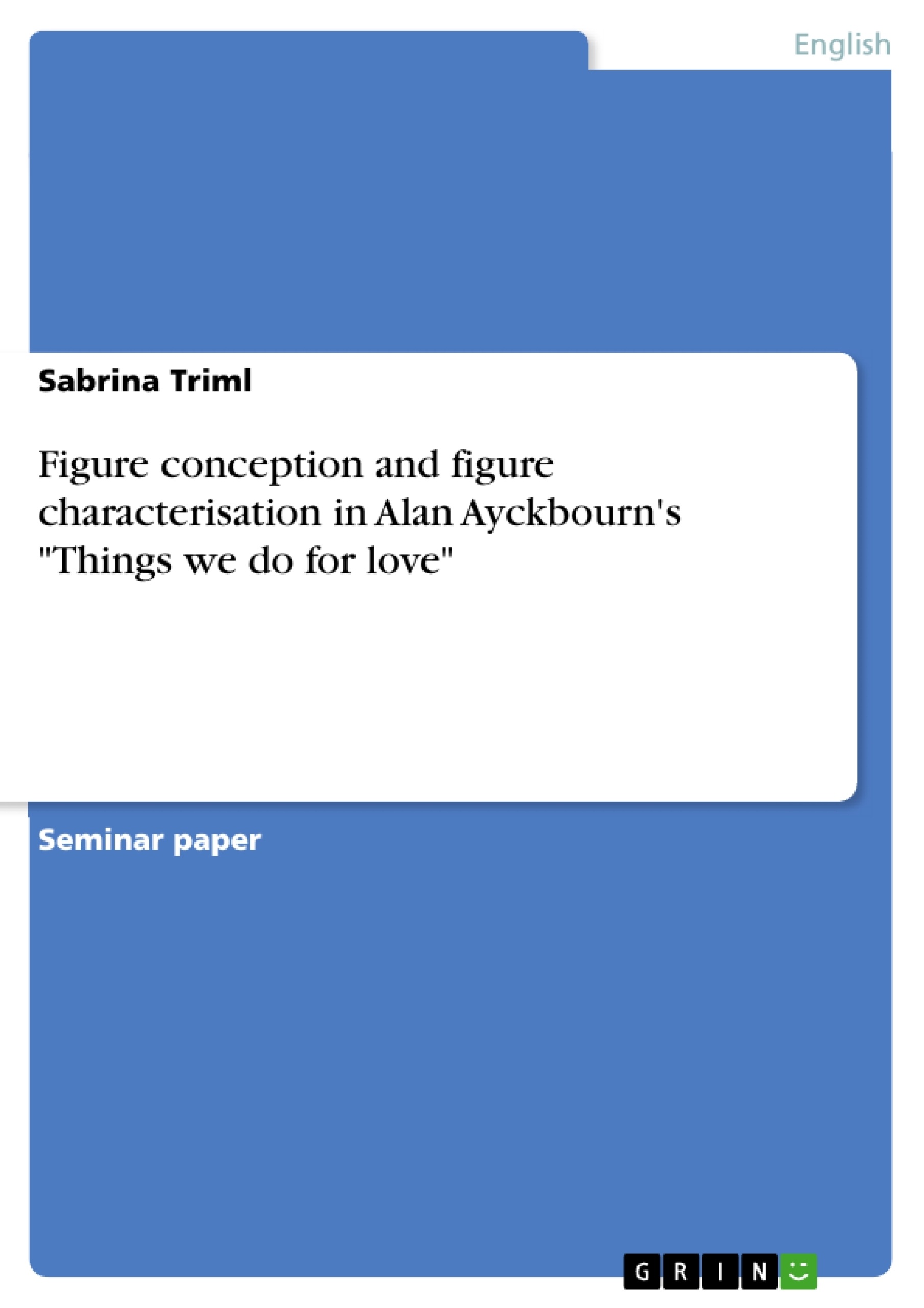Popular playwright Alan Ayckbourn is admired by his audience for his interesting character portrayals and insights into human relationships. The aim of this paper is to outline figure conception and characterisation in Alan Ayckbourn’s play "Things We Do for Love".
Inhaltsverzeichnis (Table of Contents)
- INTRODUCTION
- GENERAL CHARACTERISTICS OF AYCKBOURN'S FIGURES
- THE ENGLISH MIDDLE-CLASS
- GENDER
- HUMAN RELATIONSHIPS
- ROUND AND FLAT CHARACTERS
- FIGURE CONCEPTION IN THINGS WE DO FOR LOVE
- BARBARA
- NIKKI
- HAMISH
- GILBERT
- FIGURE CHARACTERISATION IN THINGS WE DO FOR LOVE
- EXPLICIT-FIGURAL CHARACTERISATION TECHNIQUES
- Self-commentary
- Outside Commentary
- Offstage Characters
- IMPLICIT-FIGURAL CHARACTERISATION TECHNIQUES
- Non-verbal techniques
- Verbal techniques
- EXPLICIT-AUTHORIAL CHARACTERISATION TECHNIQUES
- Speaking Names
- Descriptions in the secondary text
- Setting
- IMPLICIT-AUTHORIAL CHARACTERISATION TECHNIQUES
- Interpretative Names
- Correspondence and Contrast
- EXPLICIT-FIGURAL CHARACTERISATION TECHNIQUES
- CONCLUSION
Zielsetzung und Themenschwerpunkte (Objectives and Key Themes)
This paper aims to explore the figure conception and characterization in Alan Ayckbourn's play "Things We Do for Love". It will first analyze recurring themes and general characteristics of Ayckbourn's figures, focusing on the middle-class setting, gender dynamics, and problematic relationships. Then, the paper will delve into specific examples of figure conception and characterization in "Things We Do for Love", highlighting the use of explicit and implicit techniques to portray the characters.
- English Middle-Class Society: The play explores themes of social class, focusing on the lives and experiences of middle-class characters.
- Gender Dynamics: The paper examines the portrayal of men and women in Ayckbourn's work, highlighting the difficulties and complexities of relationships between genders.
- Problematic Relationships: The study analyzes the relationships between friends, family, lovers, and especially married couples in Ayckbourn's plays, exploring themes of love, hate, deception, and betrayal.
- Figure Conception and Characterization: The paper analyzes the techniques used by Ayckbourn to create and portray his characters, including self-commentary, outside commentary, nonverbal techniques, and verbal techniques.
- Human Relationships: The analysis focuses on Ayckbourn's keen observations and insights into the complexities of human relationships, drawing attention to the recurring theme of problematic relationships within his work.
Zusammenfassung der Kapitel (Chapter Summaries)
The paper begins with an introduction to the playwright Alan Ayckbourn, highlighting his talent for clever technique and insightful character portrayals. The introduction establishes the goal of the paper, which is to analyze figure conception and characterization in "Things We Do for Love".
Chapter two delves into the general characteristics of Ayckbourn's figures, emphasizing their middle-class background, the dynamics of gender roles in his work, and the recurring theme of problematic relationships. The chapter further examines how Ayckbourn depicts these characters, focusing on the use of round and flat characters.
Chapter three focuses on figure conception in "Things We Do for Love", exploring the specific characters of Barbara, Nikki, Hamish, and Gilbert. The chapter analyzes how each character is introduced and developed within the play.
Chapter four delves into figure characterization in "Things We Do for Love", examining the techniques used by Ayckbourn to portray his characters. The chapter discusses explicit-figural and implicit-figural characterization techniques, exploring various aspects of their portrayal, including self-commentary, outside commentary, nonverbal techniques, and verbal techniques.
Chapter five, the Conclusion, is excluded from this preview to avoid spoilers.
Schlüsselwörter (Keywords)
The main keywords and focus topics of this paper include: Alan Ayckbourn, "Things We Do for Love", figure conception, characterization, English middle-class, gender dynamics, problematic relationships, round and flat characters, explicit-figural techniques, implicit-figural techniques, self-commentary, outside commentary, nonverbal techniques, verbal techniques, human relationships.
- Quote paper
- Sabrina Triml (Author), 2001, Figure conception and figure characterisation in Alan Ayckbourn's "Things we do for love", Munich, GRIN Verlag, https://www.grin.com/document/83497




